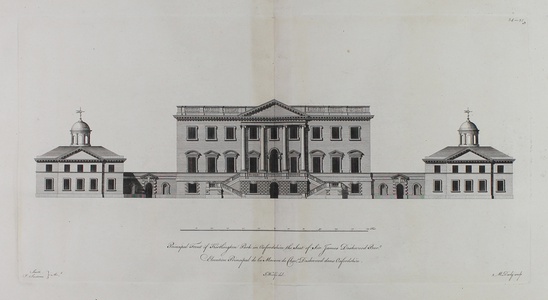| Method | Copper engraving |
| Artist | Matthew Darly after John Woolfe |
| Published | J. Woolfe del. M. Darly sculp. [London, 1765-1771] |
| Dimensions | Image 165 x 470 mm, Plate 255 x 500 mm, Sheet 560 x 705 mm |
| Notes |
Titled in English and French. A finely engraved architectural view of the principal elevation of Kirtlington Park, Oxfordshire, built for Sir James Dashwood in 1742, from the Woolfe and Gandon volumes of Vitruvius Britannicus, or, The British Architect. The house was designed by the architects William Smith and John Sanderson. Vitruvius Britannicus or, the British Architect. Containing the Plans, Elevations, and Sections of the most Regular Buildings both Publick & Private in Great Britain was the first architectural work to emerge from England since John Shute's The First and Chief Groundes of Architecture, which was first printed in 1563. Often regarded as a catalogue of designs, Vitruvius Britannicus contained a number of plans, elevations, and sections of buildings in Great Britain by the most prominent architects of the day, including Inigo Jones and Sir Christopher Wren. The text as well as a great many of the designs were the work of the Scottish architect Colen Campbell, with the first three volumes being published between 1715 and 1725. The success of Vitruvius Britannicus was instrumental in popularising neo-Palladian Architecture in Great Britain and America during the eighteenth century, and was one of the driving forces behind the development of Georgian architecture. The book inspired two significant imitators, both of whom borrowed the title for their own publications. The first, in 1739, was published by Badeslade and Rocque, but featured mostly topographical views. Between 1765 and 1771, the architects Woolfe and Gandon issued their own two volume set as Vitruvius Britannicus Volumes IV and V. In style, their publication was a much closer fit to the Campbell originals, and featured some of the finest examples of architecture to have appeared in the 40 years between the two books. John Woolfe was an Irish draughtsman active in the latter half of the eighteenth-century. From the 1750s onwards, Woolfe was employed in the Office of Works. He was the joint author with James Gandon of volumes 4 and 5 of Vitruvius Britannicus. His son, of the same name, worked for the Office of Works between 1787 and 1806. Matthew Darly (c.1721-c.1792) was a British caricaturist, printseller, publisher, and ornamental engraver. In 1759, he married his second wife Mary (fl.1759-1792), also a caricaturist and printseller, who wrote and illustrated the first book on caricature drawing, A Book of Caricaturas, 1762. The Darlys worked together and independently, and by 1756, they had print shops in Fleet Street and the Strand. Most of their prints were engraved in a very similar style and, to complicate attribution, have a publication line of 'M.Darly', so differentiation between them is often difficult. Mary's plates were predominantly satires and caricatures, whereas Matthew, in addition to caricatures, was also a jobbing engraver and stationer, producing everything from topography to trade cards. Colen Campbell (1676-1729) was a Scottish architect and architectural writer, credited as a founder of the Georgian style. He is best known as the author of Vitruvius Britannicus. Condition: Central vertical fold, as issued. Minor creasing to plate. |
| Framing | unmounted |
| Price | £250.00 |
| Stock ID | 50858 |

